Teach Kid to Ride Bike Without Training Wheels

Kristina
—Sep 09, 2024
Teaching your child to ride a bike without training wheels is a very rewarding experience for a parent. It’s a milestone that builds confidence, coordination, and independence in your child and deep pride in yourself.
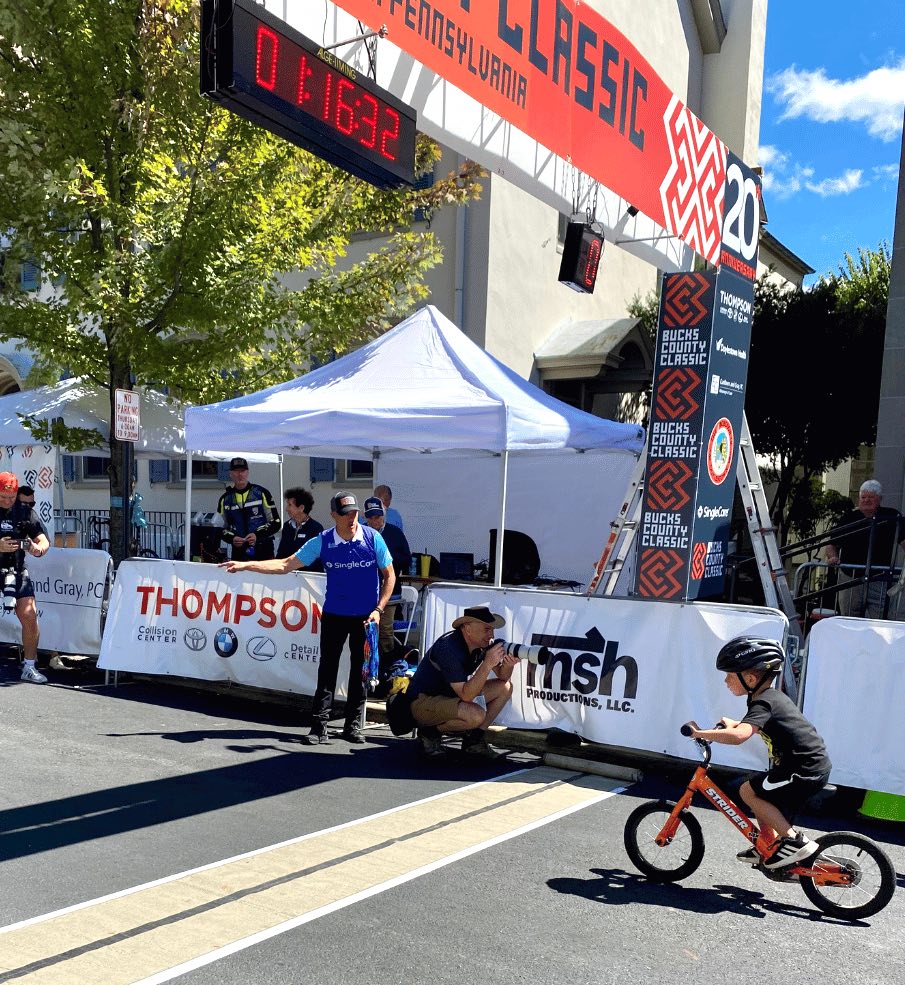
My two sons learned to ride their pedal bikes without training wheels at the ages of 3 and 4. The second they took off they were glued to those bikes for a solid month using every spare moment to go outside and ride! It makes a great outdoor activity!
One of the most effective ways for a kid to learn to ride a bike without training wheels is to start with a balance bike. In this article, we’ll walk you through reasons why balance bikes are a game-changer and outline the steps to help your child master riding without training wheels. And don’t worry if your kid already has training wheels we’ll talk about how to ditch the training wheels.
In this Article:
- Why Can Training Wheels Be Bad?
- What is the Average Age Kids Learn to Ride a Bike?
- Why Start with a Balance Bike?
- What Age Should a Child Have a Balance Bike?
- Steps to Teach Your Child to Ride a Bike Without Training Wheels
- How Long Does it Take to Master a Balance Bike?
- What Age Should a Child Have a Balance Bike?
- What if My Child Already Has Training Wheels?
- Transition to a Pedal Bike
- Pedaling on a Bike Without Training Wheels
However if you are struggling for your child to want to ride a bike check out How to Motivate Kids to Ride a Bike More.
Why Can Training Wheels Be Bad?
Training wheels allow a kid to learn how to pedal, but not how to balance on two wheels. A kid heavily leans on a bike with training wheels for support and can struggle to learn to ride without them.
When you remove the training wheels from a child who is used to it they often have to start from scratch to relearn how to ride a bike. This is because the first thing a child needs to understand when riding a bike without training wheels is balance. And training wheels don't allow a kid to learn this.
The hardest thing about riding a bike for a kid is balance.
What is the Average Age Kids Learn to Ride a Bike?
Stanford Medicine Children’s Health states that on average kids aged 4 to 8 develop enough coordination, agility, and a sense of balance to graduate to a bike without training wheels.
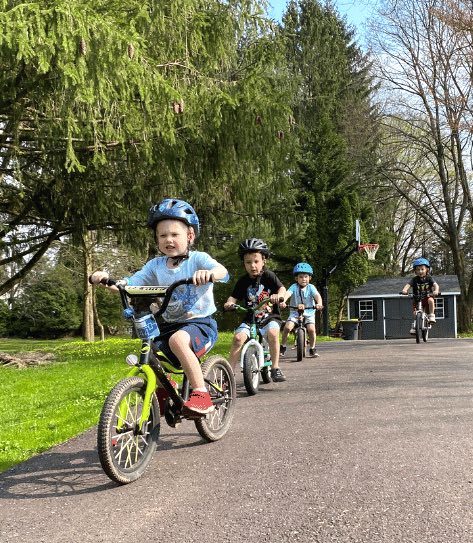
MPR news reports that kids who first used balance bikes learn regular bikes in less time, up to two years younger than their peers using training wheels.
From my personal experience, having first used a balance bike my kids were ready at ages 3 and 4 for pedals. They never rode a bike with training wheels and transitioned with ease to pedals. Learning to ride a bike without training wheels does not have to be a big deal.
Why Start with a Balance Bike?
A balance bike is a pedal-less bike designed to teach a kid how to handle a bike (balance) and to steer. By focusing solely on balance, your child first masters the bike before adding another layer of complexity on it, pedals.
If a child first learns to balance, once you introduce pedals they understand how the bike can fall and how to keep it upright.

When my 4 year old went from his balance bike to putting on pedals, he didn't fall. He was so comfortable with the bike he hopped on and before I could grab my camera he was pedaling down the driveway!
Benefits of a Balance Bike:
- Improves Balance and Coordination: Without the complication of pedaling, kids learn to balance and steer more effectively.
- Boosts Confidence: Mastering balance on a balance bike gives children a sense of achievement, making them more eager to try pedaling.
- Simplifies the Transition: When kids are comfortable balancing, they can more quickly learn to pedal and steer on a traditional bike.
- Builds Independence: Don’t underestimate the power a young child feels crushing down the road on a balance bike faster than their parents can keep up. My 2 year old has been a speed demon on hers since the age of 1.
What Age Should a Child Have a Balance Bike?
Most experts agree, and from my personal experience with three kids, that at around 18 months a child is ready to be introduced to a balance bike. Whether or not a child shows interest in a balance bike at that age is another question.
A balance bike is a perfect outdoor toy for a toddler.
Not all 18 month olds will be interested in a balance bike and that is okay. With my three kids my oldest didn’t ride his till 3.5 years, my middle right at his third birthday and my youngest at 18 months.
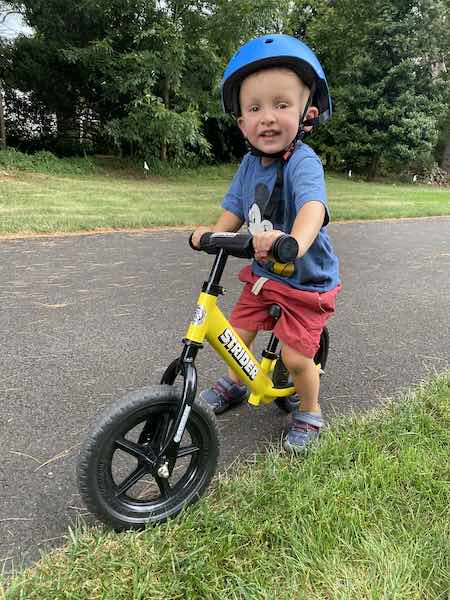
Toddler age is the perfect age for a kid to learn the balance bike and master it. However, if you are late to the game there are larger balance bikes or the option to take the pedals off bikes to stimulate the balance bike.
My boys who took to the balance bike later in their toddler years had no issues transitioning to a pedal bike with no training wheels. My daughter just got to spend more time on her balance bike riding with her brothers.
Steps to Teach Your Child to Ride a Bike Without Training Wheels
1. Choose the Right Balance Bike
Select a balance bike that fits your child’s height and is comfortable for them to handle. The seat should be adjustable so your child can touch the ground with their feet when seated. The lighter the bike is the easier the bike will be for the little ones to handle.
My kids have all used a Strider 12X bike and it has been perfect. We have tried a couple other brands, but they have been heavier and harder for a toddler to handle. For my full review read My Strider Bike Review.
And don’t worry if your child is no longer a toddler they can still first learn a balance bike.
Balance Bike Choices:
| Bike | Product | Recommended Age |
|---|---|---|
Strider 12x | 18 month- 3 year olds | |
Retrospec Cub 12 X | 18 month - 3 year olds | |
Woom 12X | 18 months - 3 year olds | |
Banana Balance Bike | 18 month - 3 year olds | |
Strider 14X | 4 - 6 year olds | |
Bixie 16X | 4 - 9 year Olds |

2. Introduce the Balance Bike
Start by familiarizing your child with the balance bike. Let them explore it, sit on it, and walk it around to get used to the feel. Encourage them to push off with their feet and glide along.
Be patient and don’t push it. If you can be around other kids that are on balance bikes or pedal bikes this can help grow interest for your child. Pushing too hard will only start to build a negative feeling towards their balance bike.
3. Practice Balancing
Encourage your child to push the bike forward with their feet and then lift their feet off the ground to glide. When they do give lots of praise. Kids love praise!
Practice in a safe, open space where they can build confidence. Driveways are great for this, pathways or quiet neighborhood roads also work well. Your kid might only want to practice for a couple minutes, but other days half an hour. Let them decide.
4. Increase Glide Time
Gradually your kid will extend the distance they glide as their balance improves. For my kids this was as early as 21 months and late as closer to 3 years. Wait it out, but as long as they are practicing with their balance bike they are doing great.

If it helps let your kid watch a video of another kid gliding on a balance bike or watch an older sibling/friend.
5. Introduce Steering
Once your kid has mastered gliding, give them more chances to turn while gliding. Take them to a pump track or build a race course in the street with curves. Steering comes hand and hand with gliding so this might be done at the same time.
Once your child is steering and gliding on a balance bike like a pro they are ready for a pedal bike without training wheels.
How Long Does it Take to Master a Balance Bike?
This depends on when they started a balance bike. An 18 month old who is given a balance bike might not master it for a year or longer, because developmentally they need more time.
An older child, aged 4+, could master a balance bike in as short as a weekend! However, if your child has first had training wheels it might take them a week or so to adjust to not relying on the training wheels for balance.
What Age Should a Child Have a Balance Bike?
The earlier a child has a balance bike the sooner they can start to learn. A balance bike can be introduced to a child as young as 18 months old and there is no upper age limit. Learning to balance should be the first step in learning to bike without training wheels.
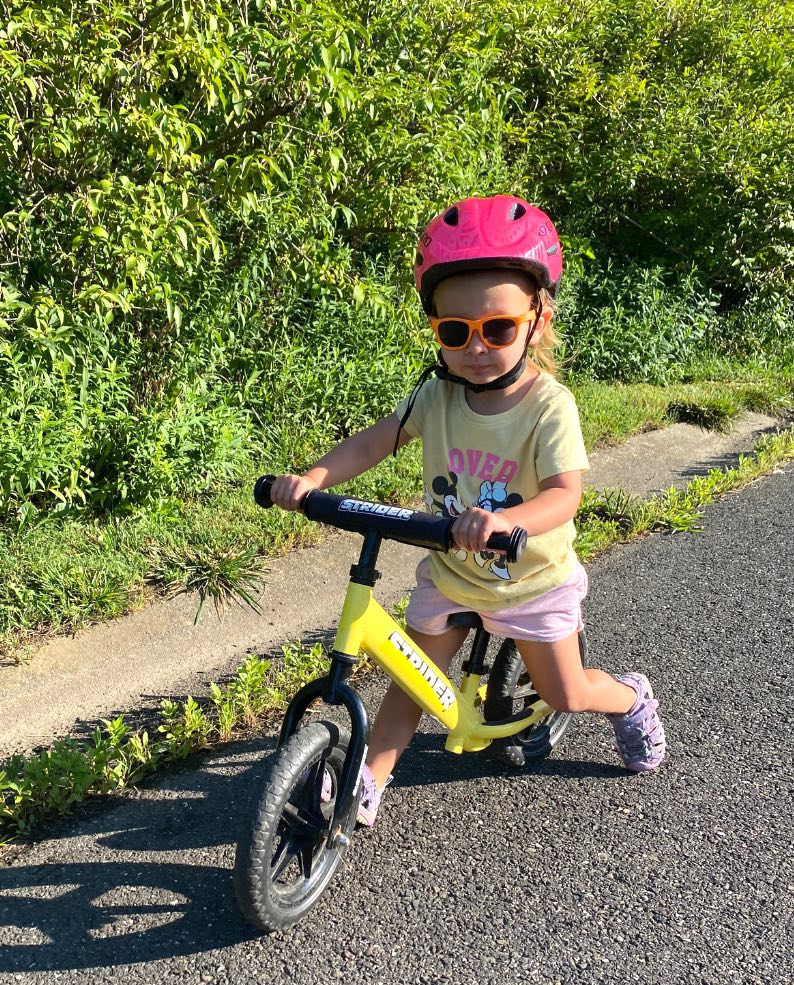
Not all 18 month olds will be interested in a balance bike and that is okay. With my three kids my oldest didn’t ride his till 3.5 years, my middle right at his third birthday and my youngest at 18 months.
My boys who took to the balance bike later in their toddler years had no issues transitioning to a pedal bike with no training wheels. My daughter just got to spend more time on her balance bike riding with her brothers.
What if My Child Already Has Training Wheels?
If your child already has training wheels don’t worry. First remove the training wheels from the bike. You can either also remove the pedals of that bike or use a balance bike.
Start by going through the steps to master a balance bike. Then once they have mastered the balance bike you can reintroduce the pedal bike without training wheels. Do not let your child ride a bike with training wheels when trying to teach them the balance bike, remember the goal is to learn a bike without training wheels.
Steps for Kids Learning to Ride a Bike Without Training Wheels who First had Training Wheels
- Take off pedals and training wheels and master the balance bike
- Don’t allow a kid to ride a bike with training wheels
- Remember to be patient and keep it fun
- Once a they have mastered the balance bike you can transition back to pedal bike
Transition to a Pedal Bike
Once your kid is confident and has mastered the balance bike you want to introduce the pedal bike. Now I won’t introduce a pedal bike to my 2 year old, she is not developmentally ready for it. Any child over 3 who can tell you they want to move up to a pedal bike after they have mastered a balance bike is ready to start.
Transition to Pedal Bike By Adding Pedals to Balance Bike
Some balance bikes give you the option to transition to pedals on the same bike. We used the Strider 14x balance bike to convert to a pedal bike.
Advantages of using same balance bike converted to pedal bike
- Familiarity of the bike: child does not have to get use to different length handlebars, stems, reaches or saddle positions
- Child understands handling and balancing of that bike
A disadvantage could be that the bike is on the smaller size for the pedal bike and you will need to upgrade the bike size in the near future. However it is easier for them to first learn on a familiar bike before upsizing to a larger pedal bike than starting on a larger bike.

Balance Bikes that Convert to Pedal Bikes
- Strider 14x: Available in 3 colors, pedal kit sold seperately
- LittleBig Bike 14x : Available in 5 colors, pedal kit sold separately
- SmarTrike Xtend 14x: Currently unavailable
- Strider 20x Sport: Great for older kid learning 8+, available in white, pedal kit sold separately
Transition to Pedal Bike with New Pedal Bike
You can also teach your child to learn without using a balance to pedal bike. Most bikes allow you to remove the pedals, thus becoming a balance bike. I recommend doing this so a kid first gets comfortable on the bike and understands the balance and steering.
Once a kid is comfortable on the bike without the pedals you can add the pedals back on.
Pedaling on a Bike Without Training Wheels
Now that we have mastered the balance bike and introduced the pedals we are ready to learn the pedal bike.
Some kids can easily hop on the pedal bike, with no training wheels, and take off. They already understand the bike and for some kids pedaling won’t be a challenge.

If a kid is already used to a bike that kid will also already know how to use the brakes on the bike and that won’t be a problem.
My two boys didn’t need any further instructions, they hopped on the pedal bike and were off and could easily stop.
Now if this is not the case, no worries. Let’s continue the steps to getting your child to ride a bike without training wheels.
Setting for Success to Ride Bike Without Training Wheels:
- Start on a flat, smooth surface** **or slight downhill
- Have a kid master going straight before introducing turning
- Show them** **how to brake, if not mastered yet
- Use positive reinforcement
- Hold bike up till child is on pedals, if necessary
- Practice, Practice and Practice
- If a kid falls, encourage them to try again
What if a Kid Doesn’t Understand How to Pedal?
If a kid has mastered a balance bike and cannot figure out how to pedal that is okay. They might be too young to learn to ride a pedal bike. My 2 year old has mastered the balance bike, but I will wait until she is 3 to begin on a pedal bike.
If a kid is older and still struggling with the pedal motion I suggest letting them ride a tricycle. This will allow them to understand how pedaling works without slowing down all your efforts to master balancing a 2 wheeled bike. Since you don’t have to balance a tricycle there is no negative effect.
Once a kid has mastered pedaling a tricycle and mastered handling the balance bike, move forward to introducing the pedals.
Safety First with Kids and Bikes
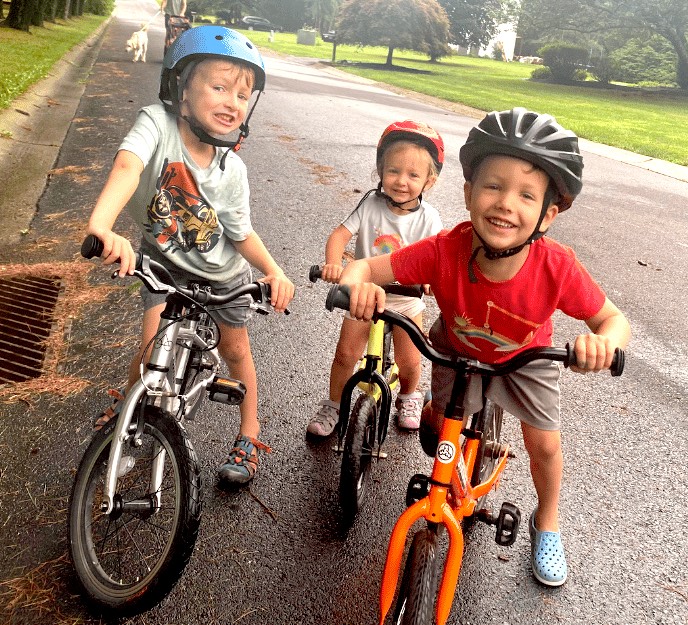
Always ensure your child wears a helmet. Supervise their riding to make sure they are confident safe riders before letting them partake without you.
Helmet Safety for Kids
- Helmet should rest two fingers wide above kid’s eyebrows
- Strap should be secure without excess
- Helmet shouldn’t move when a child moves head from left to right
- No visible cracks
Teach kids road safety including how to stop for lights and stop signs. Make sure they look both ways before crossing intersections and use crosswalks properly.
If available, have kids ride on sidewalks.




